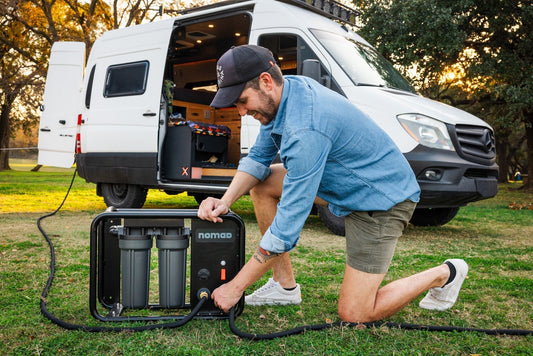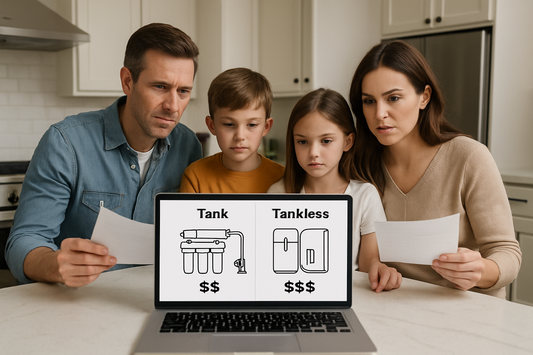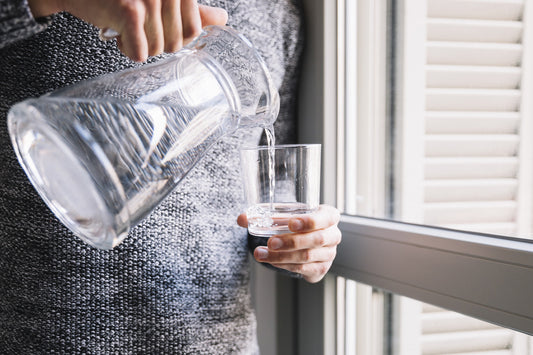Quick Answer: Tankless reverse osmosis systems deliver the same purification power as traditional RO units but eliminate bulky storage tanks, reduce water waste by up to 50%, and fit in compact under-sink spaces. They're ideal for modern homes where space matters and efficiency drives decisions.
If you're dealing with contaminated tap water—whether it's lead from aging pipes, chlorine taste from municipal treatment, or bacteria from well water—you've likely considered a reverse osmosis system. But here's what most homeowners don't realize: the bulky tank-based RO systems of the past are rapidly being replaced by sleek, tankless alternatives that solve the biggest complaints about traditional reverse osmosis.

What Makes Under Sink RO Systems Different
Space-Saving Design Revolution
Traditional reverse osmosis systems require a 3-4 gallon storage tank that dominates your under-sink area. A tankless reverse osmosis system produces filtered water on-demand, freeing up valuable cabinet space for storage while delivering the same contaminant removal rates.
Modern tankless units like those from Crystal Quest and Waterdrop measure roughly 16" x 6" x 18"—about the size of a shoebox—compared to traditional systems that can consume half your under-sink cabinet.
Improved Water Quality and Freshness
Tank-based systems store filtered water for hours or days, potentially allowing bacterial growth in stagnant conditions. Tankless systems filter water instantly as you use it, ensuring maximum freshness and eliminating the stale taste that sometimes develops in stored RO water.
How Tankless RO Systems Solve Common Water Problems
Lead and Heavy Metal Removal
With aging infrastructure affecting water quality nationwide, lead contamination remains a serious concern. A quality reverse osmosis system under sink removes up to 99% of dissolved lead, mercury, and other heavy metals through its semipermeable membrane—regardless of whether it's tankless or traditional.
Chlorine and Chemical Elimination
Municipal water treatment relies heavily on chlorine, creating that distinctive "pool water" taste and odor. RO systems eliminate chlorine and chloramines through activated carbon pre-filtration, while the RO membrane removes chlorine disinfection byproducts that carbon alone cannot catch.
Bacteria and Virus Protection
Well water users face unique challenges with biological contamination. The 0.0001-micron pores in RO membranes physically block bacteria, viruses, and cysts that can cause waterborne illness—providing a crucial safety barrier for families on private water supplies.
The RO Filtration Process: What Really Happens
Stage 1: Sediment Pre-Filtration
Water first passes through a 5-micron sediment filter that captures visible particles like dirt, rust, and debris. This protects the expensive RO membrane from premature clogging and extends system life.
Stage 2: Carbon Pre-Filtration
Activated carbon removes chlorine, which would otherwise damage the RO membrane. This stage also reduces many chemical contaminants and improves taste and odor.
Stage 3: Reverse Osmosis Membrane
Here's where the magic happens. Pressurized water is forced through a semipermeable membrane with pores 1000 times smaller than bacteria. Only pure water molecules pass through, leaving contaminants behind to be flushed away.
Stage 4: Final Carbon Polishing
A final activated carbon stage removes any remaining tastes or odors, delivering crisp, clean water to your tap.

Image by dmitrytph
Tankless vs Traditional RO: The Real Comparison
Water Waste Reduction
Traditional RO systems typically waste 3-4 gallons for every gallon produced. Advanced tankless systems like those from Waterdrop achieve 2:1 waste ratios—cutting water waste in half while maintaining the same filtration effectiveness.
Maintenance Differences
Tankless systems eliminate tank sanitization requirements but may need more frequent membrane cleaning due to continuous operation. However, most users find the trade-off worthwhile for the space savings and improved water freshness.
Flow Rate Considerations
Traditional systems provide instant high flow from stored water, while tankless units may have slower flow rates (0.5-0.75 GPM). For most households, this difference is negligible for drinking water use.
Choosing the Right Under Sink RO System
Assess Your Water Quality First
Before selecting any system, test your water to identify specific contaminants. While RO removes most dissolved contaminants, you may need additional pre-treatment for high levels of iron, hydrogen sulfide, or other specific issues.
Consider Your Space Constraints
Measure your under-sink area carefully. If space is tight, a tankless system is often the only viable option. If you have ample room and prefer maximum flow rate, a traditional system might work better.
Budget for Long-Term Costs
Initial costs for tankless systems run $200-800, while traditional systems cost $150-600. However, factor in replacement filter costs—typically $100-200 annually regardless of system type.
Installation and Maintenance Requirements
Professional vs DIY Installation
While many homeowners can install a reverse osmosis system under sink themselves, proper installation requires basic plumbing skills and attention to detail. Improper installation can lead to leaks, poor performance, or system damage.
Key installation considerations include adequate water pressure (40+ PSI), proper drain connection, and correct filter orientation.
Ongoing Maintenance Schedule
- Pre-filters: Replace every 6-12 months
- RO membrane: Replace every 24-36 months
- Post-filters: Replace every 12-18 months
- System sanitization: Annually (traditional tanks only)
Common Misconceptions About RO Systems
"RO Water Lacks Essential Minerals"
While RO removes beneficial minerals along with contaminants, most people get minerals from food, not water. If mineral content concerns you, many systems offer optional remineralization stages.
"All RO Systems Are the Same"
Quality varies significantly between manufacturers. Look for NSF-certified systems with documented contaminant removal rates rather than generic claims.
"Tankless Systems Are Just a Fad"
Tankless technology represents genuine advancement in efficiency and space utilization, not just marketing. As home sizes shrink and efficiency demands increase, tankless systems offer practical advantages.
When RO Isn't the Right Choice
RO excels at removing dissolved contaminants but isn't always necessary. If your main concerns are sediment, chlorine taste, or basic filtration, a whole house carbon filter system might be more cost-effective.
For comprehensive water treatment including hardness, consider a water softener and filtration combo that addresses multiple water quality issues simultaneously.
FAQ Section
How long do tankless reverse osmosis systems last?
With proper maintenance, quality tankless RO systems last 10-15 years. The key is replacing filters on schedule and protecting the system from water pressure spikes or freezing.
Can I install a tankless RO system myself?
Most homeowners with basic plumbing skills can install tankless RO systems. However, if you're uncomfortable with plumbing connections or lack proper tools, professional installation ensures optimal performance.
Do tankless RO systems require electricity?
No, tankless RO systems operate purely on water pressure and don't require electrical connections. This makes them ideal for areas with power reliability issues.
What's the real difference in water waste between tankless and traditional RO?
Modern tankless systems typically waste 2 gallons per gallon produced, while traditional systems waste 3-4 gallons. Over a year, this can save thousands of gallons for average households.





